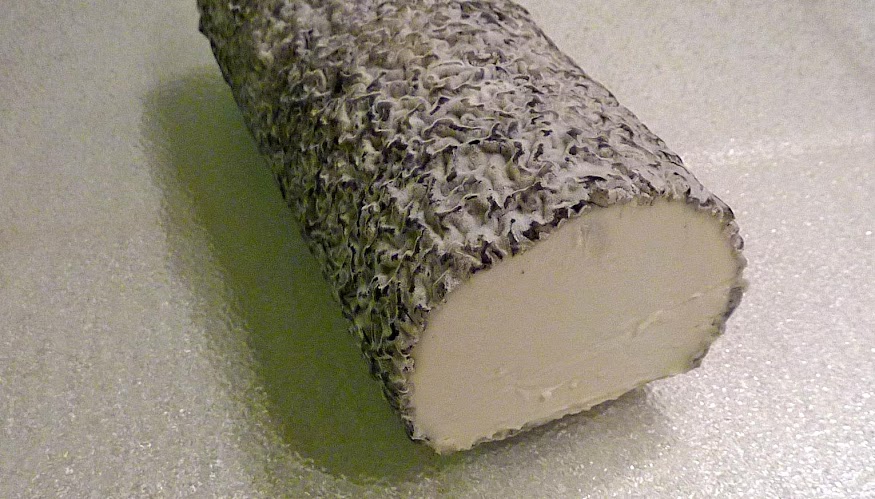There are three main styles of goat cheese — fromage de (lait de) chèvre — made in Touraine. To the west, there's the log-shaped Sainte-Maure (de Touraine). Maure is a woman's name, and she was une sainte, but the cheese is called un Sainte-Maure because it's un fromage. The other two best-known Loire Valley goat cheeses are the pyramid-shaped Valençay and the disk-shaped Selles-sur-Cher. Fortunately for us, Saint-Aignan is located right in the middle of all these cheese-making areas.
The cheese above came from our local Intermarché supermarket. It's a medium-hard (demi-sec) cheese made from raw (i.e. unpasteurized) goat's milk, salt, ash (the dark coating that forms a crust and gives flavor), and rennet (présure, the coagulating agent used to turn milk into cheese). As pictured, the cheese contains 22% milk fat — the rest is water and milk solids. You can see how pure white goat's milk cheese is. Manthelan is a small town located south of Tours, between Loches and Saint-Maure, and La Thibaudière is a farm that has a herd of 150 goats.
We don't get a bread delivery on Wednesdays, so I made some rolls yesterday. These are made with 450 grams of white wheat four, 50 grams of rye flour, and 50 grams of oat flour, along with yeast, olive oil, and water. Making bread was a good rainy-day activity (we got another third of an inch of rainfall yesterday).





Hi Ken,
ReplyDeleteWith your first paragraph you raise an important point in French. The importance of the hyphen in the language. Sainte-Maure and sainte Maure are two different things, Note the lower case S when I talk about the saint. When the saint is hyphenated it becomes a noun: town, cheese, wine, garment, what have you of any gender to honor her or him, as in Saint-Aignan. I doubt saint Aignan founded any town named after him.
Thanks, CHM, I've modified my text slightly to better explain the name Sainte-Maure and the point. French is a complex language.
ReplyDeleteThere are several towns named after a male saint named Maur, and they are called Saint-Maur.
Thanks, chm and Ken, for the punctuation/grammar/vocab lesson.
ReplyDeleteThanks, Ken, for those lovely photos of cheese and your breads!
Tell me more about those rolls- they look yummy. I'd love the recipe, tsp.
ReplyDeleteThose cheese photos are torturing me. We brought back a number of goat cheeses from our recent trip to France, but they're almost gone. During the trip we ate a lot of Sainte-Maure and Valencay type cheeses, as well as some Selles-sur-Cher. And lots of small disks. I believe all were lait cru. And those types of cheeses are pretty much unavailable in the US.
ReplyDeleteLait cru cheese is so much tastier than the ones made with pasteurized milk. Very hard to find cheese made without pasteurized milk in the US. The rolls look delicious!
ReplyDeleteI did buy some Dubliner Sharp Cheddar Cheese the other day after your Tartiflette blog! While at Costco, I noticed the Chevre but I will have to check just what kind now that I am more informed. Thank you.
ReplyDeleteYour beautifully shaped rolls must have been as good as they look.
Can you imagine trying to get the Thibaudière cheese in the us? The FDA would freak out when they realised it was un-pasteurised!!!!
ReplyDeletePas de brin de paille de seigle à l'intérieure du fromage?
ReplyDelete(BTW, it looks like the bread lady has some serious competition!)
I'm not sure why there's no straw through the cheese, Dean. There's also no AOC or AOP notation on the packaging.
ReplyDeleteThe straw only goes into a Sainte-Maure when it's an AOC cheese. It then becomes a "Sainte-Maure de Touraine".
ReplyDeleteThe lack of a straw means that it isn't AOC, its only a "fromage Sainte-Maure". Usually this indicates that it's factory made (because one of the AOC rules is that the cheese needs to be made on the farm by the person who milks the goats), but I suspect in this case that the people who run the farm where this is made don't do jumping through government hoops.
Simon, that's what I think too, because what I've read about La Thibaudière says it produces fromages fermiers. Our neighbors at La Lionnière produce some of the best goat cheeses around and they don't bother with the AOC either, since they sell only locally.
ReplyDeleteWonderful pictures of goat cheese. My mouth is watering. Many years ago we stopped for the night in Levroux and I vividly remember the wonderfully creamy cheese, which I think must be closely related to the Valencay that you mention above.
ReplyDeleteIncidentally, I never knew that saints should be named with a lower case "s". I must mend my ways!
Hello vanroaming, I've done several posts about Levroux over the years. Some of them are here. Did you know that the goat's-milk cheese now called Valençay was supposedly produced originally at Levroux?
ReplyDelete